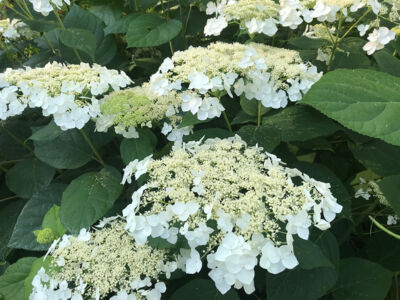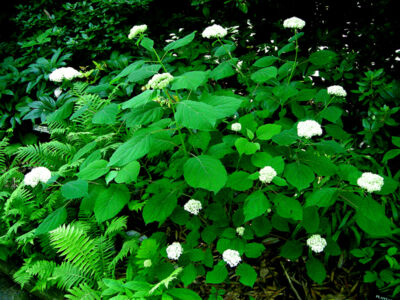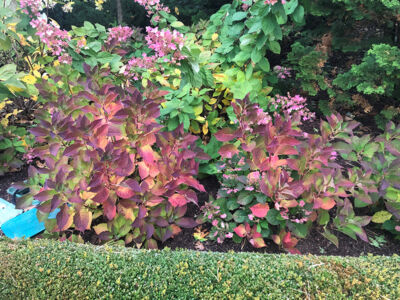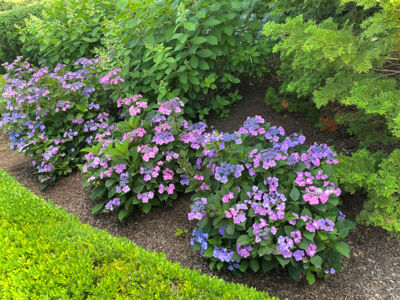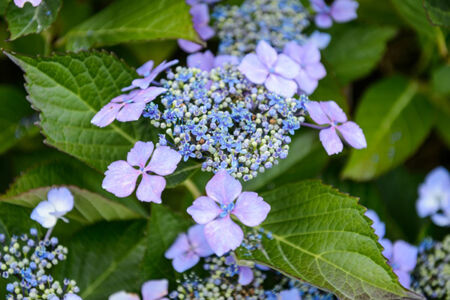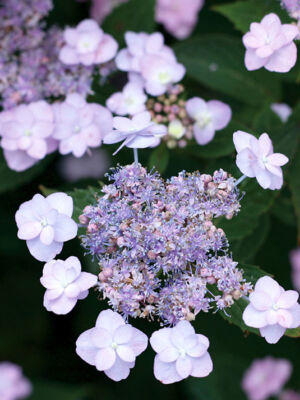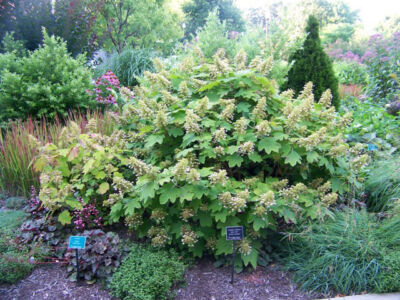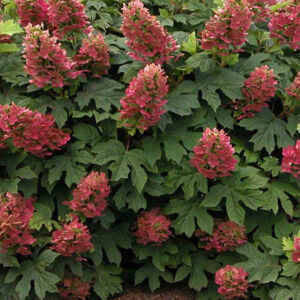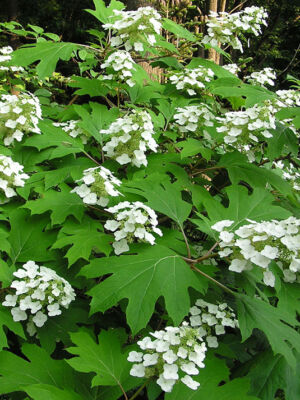Hydrangea arborescens- Smooth Hydrangea
Description
General: A low growing, clumpy, rounded shrub with many weak, non branched canes. Grows 3-5’ in height with a larger spread. Colonizes by suckering freely from the roots.
Leaves: Opposite and simple 2 to 8” long. Dark green in the summer and green to brown in the fall, though a lemon yellow can occur.
Flowers: Dull white flattened hairy clusters 4 to 6” across July through September. Flowers on new wood.
Fruit: Seed capsule ripening in October
Attributes: For massing or grouping in partially shaded areas and shrub borders. Can be used for the background of a perennial border or to naturalize in shady spots.
Culture
Hardiness: Zones 4-9. A subshrub in zones 4 and 5 as plants die to the ground each winter.
Growing Conditions: Prefers average, medium moisture soils in part shade. PH adaptable.
Maintenance: Bacterial wilt, powdery mildew, leaf spot, rusts, aphids, bud blight, scale and mites. Pruning stems to the ground in late winter/early spring helps to invigorate plants leading to more blooms and less disease.
Transplanting: Hydrangeas are fibrous rooted and very adaptable leading them to be very easily transplanted.
Our Experience
Experience at Great Hill
We have a large thicket of ‘Annabelle’, perhaps the most popular cultivar of arborescens, growing wild in our cutting garden. While “maintained’ would be an overstatement, this hydrangea has never developed a disease or insect issue aside from a general wilt that occurs in the summer during the hottest days, as this plant does not receive much shade in its current location. Its flowers are wonderful to use in dried arrangements.
Hydrangea serrata- Mountain Hydrangea
Description
General: A deciduous flowering shrub with a rounded habit growing 2 to 4’
Leaves: Opposite and simple, toothed, ovate, 2 to 6” long. Dull green color in the summer and die off either yellow, bronze, red or purple in the fall.
Flowers: Lace cap clusters up to 2” in diameter flowering either white, pink, purple, or blueish depending on the cultivar. June to August. Blooms on old wood and must be pruned directly following flower.
Fruit: Seed capsule ripening in October.
Attributes: Three season flowering shrub for massing or borders. Can be used as a specimen or accent plant as well.
Culture
Hardiness: Zones 5-9.
Growing Conditions: Prefers rich, well drained, medium soil in part shade.
Maintenance: Bud blight, bacterial wilt, leaf spot and mildew.
Transplanting: Transplants easily to moist, well drained soils in part shade.
Our Experience
Experience at Great Hill
On Great Hill, we feature mountain hydrangea in several shrub borders as well as a dwarf form (‘Tiny tuff stuff’) in our formal parterre garden. Unlike mophead hydrangeas, the mountain hydrangeas lace capped flowers stay upright and sturdy throughout the season with little to no weeping of flowers or foliage. Our flowers persist for weeks, and the purple-bronze fall leaf color is outstanding.
Hydrangea quercifolia- Oakleaf Hydrangea
Description
General: An upright, irregular, suckering, multi-stemmed deciduous shrub. Typically grows 4 to 6’ in height in the landscape, but can reach 8 to 10’ over time, especially in width due to suckering habit.
Leaves: Opposite and simple, 3 to 7 lobed and 3 to 8” long. Leaves are oak like and dark green in the summer, changing to shades of red, orange-brown, and purple in the fall. New growth emerges folded and grayish-green. Very ornamental.
Flowers: 3 to 4” panicles June through July. White, changing to purplish pink, and finally brown.
Fruit: Seed capsule ripening in October. Old flower inflorescences persist through the winter.
Attributes: A plant for the shrub border, massing or grouping. Can also be used as a specimen or accent plant.
Culture
Hardiness: Zones 5-9.
Growing Conditions: Prefers moist, fertile, well drained soil in sun to part shade.
Maintenance: Few disease issues. Deer can be a problem. Prune directly following flowering.
Transplanting: Transplants well, but is tender as a young plant. Cultural guidelines must be met.
Our Experience
Experience at Great Hill
We do not currently feature oakleaf hydrangea on Great Hill, but are hoping to add some dwarf cultivars to the property in the upcoming season, and will update once we’ve done so. Our history with this plant on other properties includes overall positive experiences. This is a wonderful shrub for interest in all seasons. Can take time to establish when young.
2023
Hydrangea Bloom Data 2023
| Plant Name | Bud Break | Full Bloom | Bloom Drop |
|---|---|---|---|
| serrata 'Tuff Stuff' | June 28 | July 17 | August 24 |
| paniculata 'Grandiflora' (PeeGee) | August 1 | August 20 | September 20 |
| paniculata 'Bobo' | June 27 | July 14 | August 30 |
| anomala petiolaris (climbing) | May 15 | June 3 | June 15 |
2022
Hydrangea Bloom Data 2022
| Plant Name | Bud Break | Full Bloom | Bloom Drop |
|---|---|---|---|
| serrata 'Tuff Stuff' | June 22 | July 12 | August 24 |
| paniculata 'Grandiflora' (PeeGee) | August 1 | August 23 | September 20 |
| paniculata 'Bobo' | June 26 | August 5 | September 13 |
| anomala petiolaris (climbing) | May 16 | June 8 | June 15 |

